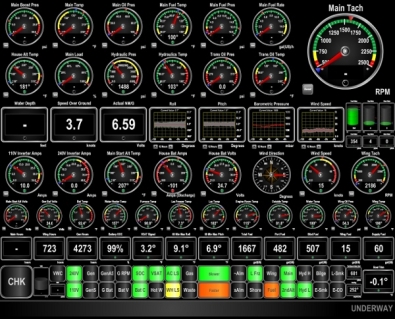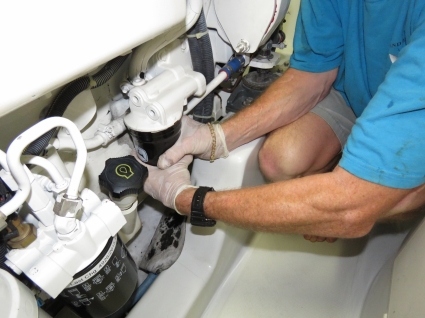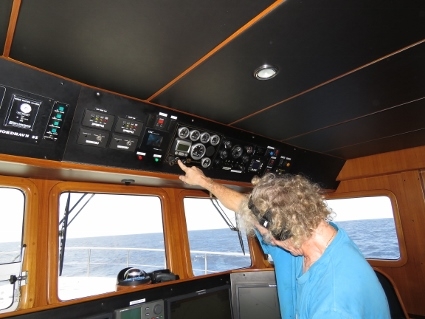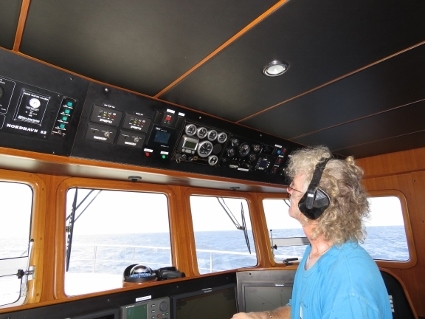Earlier this week, we brought the boat up on the wing engine and shut down the main engine to change the oil. Normally we’d never do this, even though the chance of a problem is small, because in the unlikely event that a problem does occur, it would be a very big problem. (See To Change or Not To Change, That is the Question for more detail on this decision.)
Deere, like most high speed diesel manufacturers, specifies a 250-hour oil-change interval. But they have a +50 branded oil and, if you use both their +50 oil and the Deere filter, they support a 375-hour oil-change interval. The Deere +50 oil is ACEA-E9, whereas the required oil is ECEA-E7. E7 oil is available pretty much everywhere in the world, but E9 is often unavailable. We could only get E7 in South Africa.
Covering 3,650nm at 5.5 to 6 kts would mean 608 to 663 hours of engine time. This is way too long for a single oil change, even if the last change was only two weeks earlier in St. Helena.

|

|
We changed the oil a little earlier than needed because calm seas make the job easier and and we expceted conditions to get a littler rougher from this point on. After we got everything ready to go for the change, we slowed the boat down and started the wing engine. We transferred over to wing propulsion and then transfered the hydraulics power needed by the stabiliers onto the wing as well. In the first display above, the wing tachometer is rightmost on the fourth row. (Throughout this process, the “drive to the lights” indicator at the bottom center of the display was lit orange to indicate we can go faster and still meet our fuel economy goal).
We then tried to find the calmest direction to run the boat (the diversion visible in our track on January 20th). We found running with the seas directly behind us had the least motion. Then we shut down the main engine and continued running on the wing only. It was definitely a little disconcerting to see the main engine tachometer reading zero (top right in the second display above) while hundreds of miles from land.

|

|
Jennifer stayed at the helm and helped when needed while James changed the oil and filter. The process went smoothly, and James was done in less than 15 minutes.

|

|
The moment of truth came when James pushed the button to restart the engine. Our John Deere started before the first turn of the engine, as it has every time we’ve needed it to start during the 7,173 hours we’ve owned the boat. We actually shut down the engine a second time, to check the oil level, and again the engine restarted immediately
Once everything was back to normal and we were all cleaned up, we got back up to speed and back on our original course. The Gori folding prop didn’t fold up initially, causing the wing engine prop shaft to spin with the boat motion. On the second attempt we slowed right down on the wing first before putting it in neutral and the prop folded up perfectly.
Overall the process went extremely well. We were particularily impressed with the Lugger wing engine—it ran like a champ. It’s the first time we have run on the wing engine at sea rather than in test. We were running a conservative 2200 RPM, where full-rated HP is 2800, and it was also driving the hydraulics. We were putting along at 3.7 kts and super comfortable, and the wing was running at 189F after 30 min. We suspect we could have easily been running faster—we think the wing is good for more than 4 kts continuous which is perfectly acceptable. We’ll still work hard to never need it, but it’s good to see the wing working so well.
It’s wierd to have changed the oil once in December and by January 20th to have already changed it twice more, and still be only two weeks away from needing another oil change. The hours really mount quickly when running 24×7. This is why we don’t like running the generator 24×7 and instead run the air conditioning and water maker off the main engine alternators through the 240V inverter.


James you were making 3.7 knots running with your Lugger at 2200 rpm when you changed the oil on the John Deere. Looking at the fuel consumption graph for the Lugger engine at 2100 rpm’s you are burning one gallon per hour. Assuming neutral or positive environmental conditions (wind, waves, current). You could make 3+ knots per gallon. The Lugger can run the hydraulics for the stabilizers, but what about electric. Would you have to run the generator? How long can you run on the batteries/inverter?
Your choice of a southern route was wise. Looks like Florida is as close as Charleston.
At very low speeds, we typically get excellent fuel economy. Your example of the wing engine producing better than 3 nautical MPH at around 4 kts is a great example and the main engine can deliver similar results. In most of our time in Norway we were running at 2.0 nautical MPG and at times we were up over 3.0. The reason we are currently getting around 1.1 nautical MPG is simply conditions.
The wing is a less efficient engine (200 hp from 2 liters rather than 266 hp from 6.8 liters), it give up more efficiency by having an offset prop, a bit more is given up by using a folding prop, but it has better frictional losses by being a much smaller engine. On the whole, at the same speed in the same conditions, I suspect the wing is just a bit worse than the main engine but very close.
Right now we’re running at 6.7 kts at 1700 RPM and 1.17 nautical miles per gallon. The only difference is conditions. Wind and swell on the bow really slows a boat. Large swell is far worse. And there are surprisingly strong currents out in the open ocean. There are times when we are several knots faster than normal and times when we see far less. This trip is mostly against prevailing winds so it show mostly negative results but mostly isn’t unusual for us.
The period that you point out is something is very unusual for us. It’s always been the case that, if you want better fuel economy, just slow down. But, during that period the conditions where so negative that it was not possible to get more than 1.0 nautical MPG at any speed. We’ve never seen it that poor before. It’s conceivable that we have a mechanical problem causing those terrible results but my bet is that everything is normal and the conditions are just that poor. As an example of a small mechanical problem causing serious mileage problems, we bent the prop on the tender while exploring the Brisbane river and it reduced our fuel economy to 50% of normal. We wouldn’t have made it back where it not for the contribution of a bit of gas from a work boat operator.
In this case, we believe it’s just the results of poor conditions but there is a chance we’ll find a mechanical issues. Since the fuel economy improved greatly with improved conditions, I suspect it’s just a graphic example of how poor fuel economy can be in ocean conditions. Don’t trust those fuel mileage charts computed on flat inland waters without wind and current.
Dear Sir,
In your article I red that you transferred the hydraulics from het John Deere to the wing engine to run the stabilisers, is this a standard feature on the wing engine from Nordhavn?
There is great diversity in Nordhavn’s so it’s hard to say it’s standard. On Nordhavn’s with hydrualic thrusters and windlass, it’s usual to have both a main engine hydraulic pump and a second pump on the wing engine or on a generator. On these designs you can run the stabilizer on the main or on the alternative pump.
The advantge of having a pump on the wing is that the stabilizers work when underway weather using the main engine or the backup wing engine.
Nordhavn’s with electric thrusters and windlass normally have only the single small hydraulic pump on the main engine for the stabilizers. In this design, the stabilizers only work if the main engine is running.
James,
Love the blog… With your amazing mechanical chops, I was wondering when adding the new oil back in the engine, do you do it via the reverso or from the main engine port?
This may be a case of “do as I say rather than as I do” :-). Industry recommendations are to pump out but pour in. It’s easy to pour in on a Deere — they have a large filling opening but I chose to pump both ways. It’s way faster and much less mistake prone. My general blief is that, if you make oil changes super easy and efficient, you won’t get sloppy and put them off. I can change oil in just over 10 min and since it’s that easy, it always happens on time.
I’m sure it is slightly better to pour in rather than pump. On transmissions, I do pour rather than pump back in so that old engine oil impurities don’t find there way in. For the diesel engines, I pump both ways.
I seem to recall somebody telling me the cheapest thing you can put in an engine is oil.
If you change the oil according to the manufacturer you will be doing nothing but changing oil. They want you to change it constantly because if you don’t they can deny warranty. The facts are very few engine failures happen because of the oil but that said you should look into a filtration system and use full synthetic oil if you are not already. Synthetic oil does not “wear out”, it just gets dirty. In a filtration system you only need change the filters and top up if needed because the filters filter the oil many,many more times than a OEM filter set up. The oil is maintained as new 100 percent of the time.
With 11 years and 11,500 hours on the main engine, warranty isn’t a big concern for us. You are right that oil changes are only necessary when there are impurities in the oil not removed by filtration or the additives break down. Both happen. Centrifuges are common in fleet operations like mining and 500+ hours are common. On very large engines, 1000s of hours is a pretty normal setup. I’ve spoken to oil rig operators that essentially never change oil on hours and only do it when the oil tests out of spec.
Some injector designs and some engines with worn fuel system parts can get fuel into the oil and this dilution will not be removed by advanced filtration. Our generator has some leakage past the pistons on the injector pump and in 250 hours the oil has been thinned slightly be the addition of fuel in the oil. It’s not a huge issue but stretching change intervals on that engine would require more care.
With testing, I agree engine oil changes can be deferred but testing would actually be quite a hassle for us. We’re rarely in the same spot long enough to send and receive test results and getting to the post office to send it is a hassle and finding a place to get results set back to is often challenging. It’s actually easier for us to just change the oil. An ideal solution would be to add a centrifuge and change at 500 hours and we’ve come close to making this decision in the past but the oil changes just haven’t been enough of a hassle to motivate us to make the change.
As for analysis…I have an LT Industries NIR analyzer and I am not sure if it can be used for Engine oil though I am quite sure its a spectral analysis that is performed…after all it’s looking for water, carbon and metals and such…anyway its a $55K unit and what could be interesting if you just tossed the price to the winds, inline analysis is possible so rather than just sampling you could observe and record over time…interesting to see the degradation curve to say the least but rather costly…
Now that is what I need. I absolutely need an LT Industries NIR analyzer. But, as you said, $55k is tough one to justify for someone with a fleet size of 1 :-).
I need to convince John Deere or Northern Lights or perhaps an oil company to do a research project on Dirona that depends upon me havingj an oil analyzer on board. If the research project funded the analyzer it would be highly cool. I think it would be super interesting to watch oil impurities caused by different operating modes and to investigate extended change intervals.
But for now, I change every 250 to 375 hours depending upon the oil quality I currently have on hand.
Nice work James as it now has become easier for all those who have yet to do it. Seeing success elsewhere breeds confidence.
You are so right Tim. In fact, having now done the “unthinkable” once of turning off the main engine at sea, I’ve done it again in the short time since. We had a stabilizer actuator reach end of life and need to be changed. I could just run without it since the system work surprisingly well on a single fin. But, I’m also pretty quick at changing actuators. The only downside is the main engine hydraulic pump is a live pump which means that, if the main engine is running, the hydraulic pump is pumping. I decided to just shut down the main engine, chanage the actuator, and coontinue the trip.
We get closer all the time to “at sea” not being much different from when not at sea for how we operate and maintain the boat. If it needs to be done, there is likelyhood we’ll just do it when we next have some time. This is important when running high hours in that, service is needed and we don’t want to chew up our fun time doing maintenaince. The trip is about exploring rather than maintaining the boat.
If we can do service as sea, we often do. Sometimes when the boat arrives it’s in the same or better state of service than when we left even though, on this trip, something north of 600 hours have past. In fact, ignoring the short 4 1/2 day stop in Saint Helena, we will have been at sea for more than 5 weeks.
Hi James, enjoy your daily comments on various aspects of your life onboard Dirona. On the issue of changing oil at sea on the main Deere engine have you considered a full synthetic oil with a by pass type fine filter which would safely increase the run time? Could reduce your oil change intervals substantially and keep that wonderful Deere powerplant in top form longer. What do you think?
Gary, I have given that considerable thought. Here’s my take for feedback from you folks. I would love to have the benefit of the experience of others. On synthetic oil, as you know it’s used in aviation and many other high hour or high value applications. There is no debate that sythetic is potentially better. What I have trouble witht is how to use the better. Manufacturers almost universally allow the use of synthetic oil but most, including Deere, don’t allow more hours with it’s use. So, on that model it’s a lot more expensive oil, doesn’t get more hours, but is slightly better.
I think modern dyno oils (and blends) are so darn good that I don’t think the “better” covers the cost difference of synthetic. However, if we ignore the manufacturer recommendations and run longer change intervals, the economics start to look much different and much better. The challenge, at least for me, is what hours can we safely run? Since carbon and impurities driven into the oil is why we need to replace it, I’m not sure how much longer we can run a synthetic.
The proper way to run extended change intervals is to do oil analysis and change when needed. That works well with stationary engins or engines operating in developed areas and I’ve seen the approach used very effectively. But, it’s really not practical for a boat ranging all over the world. Sending oil in for analysis is much too much of a hassle.
Without oil analysis I won’t run extended change intervals on synthetics. And, when roaming the world, oil analysis is a hassle to get done but oil is available everywhere. So, we end up just buying good quality dyno oil and not running sythetics and extended change intervals. If I had the on board gear to do oil analysis, I would just love it and be super interested in doing long term studies on extended change intervals. Actually, the more I think about that, the more interesting the idea sounds. I wonder what would be needed to do on board analysis?
I am curious how automated the procedure is and if you have any centrifugal cleaning during normal operations of the engine. My curiosity stems from some familiarity with somewhat larger engines and centrifuges. As you do travel so extensively have you looked into centrifuges for fuel and oil. I have seen some simply amazing smaller ones these days and wonder if they are applicable.
Wonderful following along with you and a I am a huge fan of Nordhavns and Trawlers in general having had the wonderful opportunity to spend some years in my youth aboard the family Grand Banks beginning with a 32 and ending several GBs later with an Alaskan. I am also the very proud father of an amazing son who is an Operations Manager in a fulfillment center and he absolutely loves his work at Amazon.
Continued safe travels!
Operations manager at a Amazon Fullfillment center is a key roll at Amazon. Congratulations to your son.
Yes, I have long been interested in centrifugal oil filtration. I got lucky at got to know the distributor of a major line of centrifuges while in Australia. They are, as you say, small and reasonably priced. The minining equipment using them are running 500 hour change intervals which is very compelling for our usage pattern. Surveying marine engine manufacturers, Scania does support them and allows a 500 hour change interval. Deere doesn’t although I think I found a nicehe applicaiton where they had approved 500 hours on a special agreement. Overall, it sounds very good to me but I always want to think through the downsides as well. If the centrifuge were to fail mechanically, it would put potentially engine destroying debris into the oil. Not especially likely but a bit of a concern.
Where I ended up on this decision is interested but not ready to commit. I would do it if Deere formally supported them but they don’t outside of one off agreements to at least one fleet operator. Even without Deere support, I would probably do if the industry had more broad experience or I could work closely with a centrifuge manufacturer. But, without any of those three things, my caution ends up winning and I conclude I can get 375 hours with high quality oil and decided to watch and learn more but wasn’t willing to jump in and install a centrifuge yet.
Well stated…I run two larger MAPX 204’s daily and while they are pretty straightforward they are not by any means trouble free and certainly come with a bit of a learning curve though nothing you would find daunting. If you gain only a 175 hour additional operating window and direct manufacturer support for the modification doesn’t exist then I would absolutely side with your judgement and refrain from one. If you could find a direct application already in place and debugged then that would perhaps make things a bit more interesting…I got all my working knowledge from a ships engineer interested in our project and he was a wealth of information for me…I will make a few inquiries and see what he comes back with just for haha’s!
Continued safe travels!
The MAPX 204 is probably larger than I can fit into our engine room but it’s a nice piece of equipment. I have seen bypass filtration systems based upon using pressurized oil spin out impurities. I have read about there using in mining but I really don’t know much about them and doubt they would remove close to what a powered centrifuge can do.
Another option in my space range are media based bypass filters. These are probably pretty good options but the companies that sell them in the US market so hard it makes the company look kind of cheap and gimicky.
I am interested in bypass filtration of all types and, if you come up with any options that you think are interesting, I would love to hear about them. Thanks John.